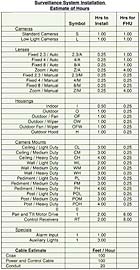System Design: Estimating & Legal

The first element of the budget is material. Within material, the first subcategory is a combined cost for cameras, lenses, housings, and mounts.

Estimate Labor
After estimating material, estimate the labor. The figure here provides a recommended breakdown of the labor cost line items. As in access control, equipment delivery and installation represents that portion of the work involving cable, conduit, camera mounts, and housings installation. Generally, this is a basic estimate of man-hours at a given rate expected from a security installation company.Likewise, final hookup for all devices is an estimate of hours for a technician from a local vendor at the anticipated rate.
Extending the project costs still further, the security professional may also want to consider recommending that the company stock their own spares for a quicker response time and lower overall costs. The value of this decision can only be measured in light of the annual maintenance costs from the selected vendor (after receipt of bids) and a careful comparison of the options.
Another consideration is planned obsolescence and system replacement. Even if the system is still operational after five years, the state of technology may render the recommended equipment obsolete and some consideration should be given to investment allowance for future replacements. However, looking that far into the future may overstep the point of diminishing returns. That is, the cost of finding the right answer may exceed the savings of early planning.
Do not overwhelm the management team with detailed costs for individual components. In most cases, the bottom line is what is most important. Some level of detail is certainly required but all the detail previously described is usually not shared in the primary recommendation. It is usually better to include detail level information on attachments.
A cost estimate would be incomplete without some review of the personnel needed to operate the system. In most circumstances, existing on-site personnel will be used as system operators, but this must be verified.
After compiling the cost data on the preliminary system, further analyze the investment in the project. The anticipated cost for the recommended security system should not exceed the value of the assets being protected. When the best efforts are made to contain costs but the investment exceeds the value of the potential loss of physical assets and there are no human assets to consider, the recommendation will usually be to use insurance or other risk aversion approaches.
Legal Issues
A recommendation for security systems can have broad implications for the security professional and the company. In today’s litigious society, companies must guard against legal exposure as a result of perceived or implied negligence. One of the frequently used phrases in legal environments with regard to security is the application of “reasonable care.”An excellent example of this perspective can be found in the healthcare industry. In addition to liabilities from medical malpractice, healthcare practitioners also have many of the same exposures as major hotels. Likewise, because of their high visibility, healthcare institutions are often exposed to “slip and fall” claims.
One of the most compelling arguments for investing in security, with regard to litigation in a healthcare institution, is the protection of children and newborn infants. Consider the case of a newborn infant disappearing from a healthcare facility. Juries find it very difficult to place a value on human life and the life of a child is especially significant. Jury awards in such cases are usually extremely high. If the institution that is being protected by the security professional is a healthcare institution that provides care to newborn infants, it follows that a single lawsuit awarded to a claimant can offset the expense of almost any physical security system.
The central question in such cases is usually “Has the institution taken reasonable care to protect the lives and property of their employees, visitors and patrons?” The definition of reasonable care tends to change with each legal jurisdiction and, within those jurisdictions, opinions changes over time. So the security professional and the company must be diligent in their efforts to constantly assess the physical security requirements and, where necessary, improve the devices, procedures and manpower to demonstrate the application of reasonable care.
The security professional must therefore consider the implied potential for loss if reasonable care is not taken and illustrate the comparison of costs for company management. At the conclusion of this analysis, the security professional must present the assessment to the management team.
Looking for a reprint of this article?
From high-res PDFs to custom plaques, order your copy today!





